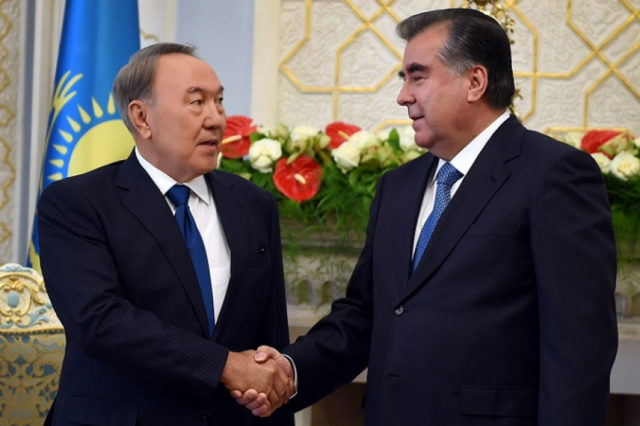
Kazakhstan and Tajikistan Renew Joint Efforts to Curb Islamic Extremism
Publication: Eurasia Daily Monitor Volume: 15 Issue: 44
By:

During the March 14 Astana summit of the leaders of all five Central Asian states (see EDM, March 20, 21), the minister of religious affairs and civil society of Kazakhstan, Nurlan Yermekbayev, and the chairman of the Religious Affairs Committee of the government of Tajikistan, Davlotzada Sulaimon, signed a memorandum on cooperation in countering religious extremism. Among other aspects, the memorandum provides a framework for sharing expertise and for establishing joint training programs, as well as for creating joint research institutions to counter terrorist and extremist activities (Government.kz, March 14).
The memorandum stresses the primacy of the respective national legislative norms of Tajikistan and Kazakhstan over regulations adopted by international organizations of which they are members, such as Collective Security Treaty Organization (CSTO) or the Shanghai Cooperation Organization (SCO). That may indicate that the two Central Asian republics do not put much faith in assistance from the CSTO in case of a serious extremist threat in the region, and prefer rely more on their own capabilities. At a press conference, President Nursultan Nazarbayev clearly articulated this point, calling for closer interaction between the security services of the Central Asian countries in the face of the growing threat posed by former Islamic State militants returning to the region from Syria to create, in Nazarbayev’s words, “dormant terrorist organizations” (Bnews.kz, March 15).
Over the last decade, both in Kazakhstan and Tajikistan, legislative norms concerning terrorism and extremism underwent substantial changes. Specifically, the focus has shifted from soft methods of “enlightenment” of the population to harsh measures designed to counter the spread of “non-traditional” religious teachings as well as outright prohibitions. In Tajikistan, Article 1 of the law “On Fighting Extremism,” adopted in December 2003, declared as one of the priorities the “protection of rights and liberties of an individual.” But subsequent amendments to the law “On National Security Bodies” gave the security forces a free hand to enter and search private properties without a warrant. In 2013, Tajikistan’s authorities closed down six madrassahs (Islamic religious schools), leaving untouched only the Islamic University. Moreover, thousands of Tajikistani students obtaining a religious education in Arab countries were forced to return home (Central.asia-news.com, November 15, 2016).
Kazakhstan’s authorities have followed similar repressive patterns when it came to dealing with religious sects and associations suspected of domestic extremist activities. The state program for countering religious extremism and terrorism for the years 2013–2017 was aimed at collaboration with wider sections of the population. Reminiscent of Communist-era declarations, the program stated that, by the year 2017, the level of preparedness of infrastructure and public buildings potentially vulnerable to terrorist attacks would reach 100 percent. But a series of terrorist attacks in the Aktobe and Atyrau regions in 2011 showed that that the stated objective has been difficult to achieve. That same year, the law “On Freedom of Faith and Religious Associations,” adopted on January 15, 1992, was replaced by a new law “On Religious Activities and Religious Associations,” which subsequently resulted in the banning of 16 religious associations deemed extremist. Some experts believe that the draft law on banning hijabs and other items of Islamic clothing, submitted to the Majilis (lower house of the Kazakhstani parliament) by the Ministry of Religious Affairs on January 29, 2018, may end up fueling further extremism (Kursiv.kz, February 7).
This past February, the National Security Committee (NSC) of Kazakhstan presented a draft program on countering religious extremism and terrorism in 2017–2020. One of the stated objectives of this document is the de-radicalization of individuals who share extremist ideas. Obviously, the move comes too late for the hundreds of Kazakhstanis who are already fighting on the side of Islamists outside the country. In 2016, the Ministry of Religious Affairs revealed that more than 200 citizens of Kazakhstan departed to Syria and Iraq to participate in combat actions on the side of various jihadist groups (Meta.kz, March 3, 2016).
According to the Prosecutor General’s office of Tajikistan, in 2017 more than 1,000 nationals joined the ranks of Islamist militants in Syria. But real figures may be much higher (Sputnik-tj.com, December 11, 2017).
Recent developments, particularly the persecution of the oppositional party Democratic Choice of Kazakhstan (DCK) and the Islamic Renaissance Party of Tajikistan (IRPT), branded as “extremist terrorist organizations” by the authorities, illustrate that counter-extremism activities can easily be used by Central Asian rulers to suppress their political opponents. The coming months will show whether the announced joint counter-terrorism and counter-extremism efforts of Tajikistan and Kazakhstan will genuinely serve to improve regional security.



